The history of the Royal Canadian Air Force begins in 1914, with the formation of the Canadian Aviation Corps (CAC) that was attached to the Canadian Expeditionary Force during the First World War. It consisted of one aircraft that was never called into service. In 1918, a wing of two Canadian squadrons called the Canadian Air Force (CAF) was formed in England and attached to the Royal Air Force, but it also would never see wartime service. Postwar, an air militia also known as the Canadian Air Force was formed in Canada in 1920. In 1924 the CAF was renamed the Royal Canadian Air Force (RCAF) when it was granted the royal title by King George V. The RCAF existed as an independent service until 1968.

The McDonnell Douglas CF-18 Hornet is a Royal Canadian Air Force (RCAF) variant of the American McDonnell Douglas F/A-18 Hornet fighter aircraft. In 1980, the F/A-18 was selected as the winner of the New Fighter Aircraft Project competition to replace CF-104 Starfighter, CF-101 Voodoo and the CF-116 Freedom Fighter. Deliveries of the CF-18 to the Canadian Armed Forces began in 1982. CF-18s have supported North American Aerospace Defense Command (NORAD) air sovereignty patrols and participated in combat during the Gulf War in 1991, the Kosovo War in the late 1990s, and as part of the Canadian contribution to the international Libyan no-fly zone in 2011. CF-18s were also part of the Canadian contribution to the military intervention against ISIL, Operation Impact. A procurement process to replace the CF-18 with the Lockheed Martin F-35 Lightning II has been ongoing since 1997.
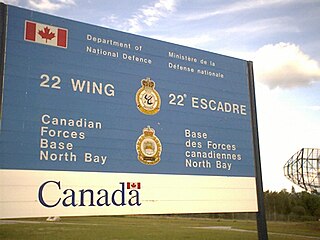
Canadian Forces Base North Bay, also CFB North Bay, is an air force base located at the City of North Bay, Ontario about 350 km (220 mi) north of Toronto. The base is subordinate to 1 Canadian Air Division, Winnipeg, Manitoba, and is the centre for North American Aerospace Defense Command (NORAD) operations in Canada, under the Canadian NORAD Region Headquarters, also in Winnipeg. It is also home to the 1 Air Force, Detachment 2 of the United States Air Force.

The Avro Canada CF-100 Canuck is a Canadian twinjet interceptor/fighter designed and produced by aircraft manufacturer Avro Canada. It has the distinction of being the only Canadian-designed fighter to enter mass production.

The Royal Canadian Air Force is the air and space force of Canada. Its role is to "provide the Canadian Forces with relevant, responsive and effective airpower". The RCAF is one of three environmental commands within the unified Canadian Armed Forces. As of 2020, the Royal Canadian Air Force consists of 12,074 Regular Force and 1,969 Primary Reserve personnel, supported by 1,518 civilians, and operates 258 manned aircraft and nine unmanned aerial vehicles. Lieutenant-General Eric Kenny is the current Commander of the Royal Canadian Air Force and Chief of the Air Force Staff.

The McDonnell CF-101 Voodoo was an all-weather interceptor aircraft operated by the Royal Canadian Air Force and the Canadian Forces between 1961 and 1984. They were manufactured by the McDonnell Aircraft Corporation of St. Louis, Missouri for the United States Air Force, and later sold to Canada. CF-101s replaced the obsolete Avro CF-100 Canuck in the RCAF's all-weather fighter squadrons. The Voodoo's primary armament was nuclear AIR-2A Genie unguided air-to-air rockets, and there was significant political controversy in Canada about their adoption. Although they never fired a weapon in wartime, the CF-101 served as Canada's primary means of air defence from Quick Reaction Alert facilities at Canadian airbases. The CF-101s were retired in the 1980s and replaced with McDonnell Douglas CF-18 Hornet fighters. Many examples are preserved in museums and parks in Canada and the United States.
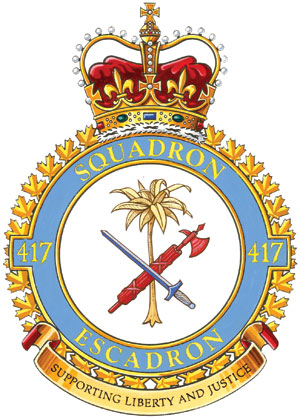
417 Combat Support Squadron is an Air Force unit with the Canadian Forces. Based at CFB Cold Lake it provides helicopter support to the base operations. Since 1994, it has also provided search and rescue.
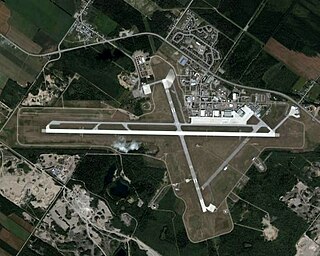
Canadian Forces Base Bagotville, commonly referred to as CFB Bagotville, and also known as Bagotville Airport or Saguenay-Bagotville Airport, is a Canadian Forces base 4.5 nautical miles west of Bagotville in the city of Saguenay. Located in the centre of Quebec, less than 200 km (120 mi) north of Quebec City, CFB Bagotville is operated as an air force base by the Royal Canadian Air Force (RCAF) and is one of two bases in the country using the CF-18 Hornet fighter/interceptor, the other being CFB Cold Lake. Its primary RCAF lodger units are 2 Wing and 3 Wing.

Canadian Forces Base Cold Lake, abbreviated as CFB Cold Lake, is a Canadian Forces Base in the City of Cold Lake, Alberta.
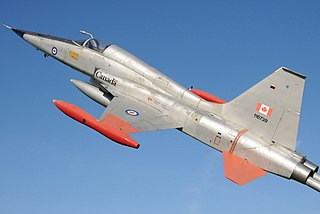
The Canadair CF-5 is a Canadian licensed-built Northrop F-5 Freedom Fighter. It is a light, supersonic, twin engine, daylight air superiority fighter primarily for the Canadian Forces and the Royal Netherlands Air Force. The CF-5 was upgraded periodically throughout its service life in Canada. While Canadian Forces retired the aircraft in 1995, it continues to be used by other countries.

419 Tactical Fighter Training Squadron was a unit of the Royal Canadian Air Force. The squadron was originally formed during the Second World War and was most recently based at CFB Cold Lake. In its latest incarnation it was responsible for advanced tactical fighter training for pilots of the RCAF and as part of the NATO Flying Training in Canada (NFTC) program using nine CT-155 Hawk trainers.

409 Tactical Fighter Squadron is a unit of the Royal Canadian Air Force. The squadron operates the CF-18 Hornet from CFB Cold Lake in Alberta, Canada.

No. 428 Squadron RCAF, also known as 428 Bomber Squadron, and 428 Ghost Squadron, was first a night bomber squadron of the Royal Canadian Air Force engaged in strategic bombing during World War II, based in Yorkshire. At the end of the war the squadron moved to Nova Scotia before being disbanded in September 1945. In 1954 the squadron was reformed as 428 All-Weather (Fighter) Squadron, before being again disbanded in 1961.
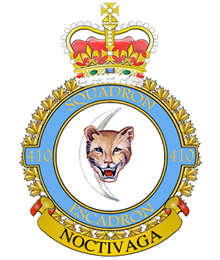
410 Tactical Fighter Operational Training Squadron, nicknamed the "Cougars", is a Royal Canadian Air Force aircraft squadron currently at Canada's primary training base for the CF-18, at Cold Lake, Alberta. The squadron was formed during the Second World War as an RCAF squadron under the Royal Air Force (RAF), at RAF Ayr, near Prestwick, in Scotland.

The Cold Lake Air Force Museum is a military aviation museum located in Cold Lake, Alberta. The museum preserves and exhibits the heritage and history of 4 Wing Cold Lake and 42 Radar Squadron. The Air Force Museum is actually one of four museums based on the old site of 42 Radar Squadron, who re-located to CFB Cold Lake in 1992. The Cold Lake Museums are connected to the Air Force Museum through a covered hallway dubbed 'The Tunnel'. All together, the museums are referred to as the Cold Lake Museums or the Tri-City Museums. The old facility of 42 Radar Squadron was decommissioned in 1992, and the museum opened its doors for the first time on July 1, 1998.

425 Tactical Fighter Squadron (French: 425e Escadron d'appui tactique, also "Alouette" Squadron, is a unit of the Royal Canadian Air Force. It operates CF-18 Hornet fighter jets from CFB Bagotville in Quebec, Canada. The squadron was originally formed during the Second World War. As of 2022, its Commanding Officer is Lieutenant Colonel Maxime "Piglet" Renaud.

440 Transport Squadron is a unit of the Canadian Armed Forces under the Royal Canadian Air Force. It is part of 8 Wing and works closely with Joint Task Force (North) in Yellowknife, Northwest Territories.

433 Squadron is a unit of the Royal Canadian Air Force. It operates CF-18 Hornet fighter jets from CFB Bagotville in Quebec, Canada. As of 2024, its Commanding Officer is Lieutenant Colonel Aaron "Slumdog" Dhillon.
Air Defence Command was a command of the Royal Canadian Air Force and later the Canadian Armed Forces, active from 1951 to 1975.

















